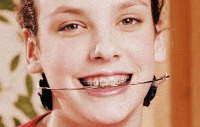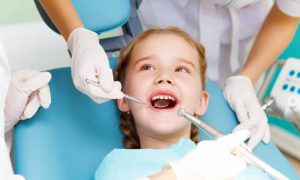The term “overbite” is used in Orthodontics to describe a bite problem where the upper teeth protrude out over the lower teeth. The lower teeth can be totally hidden by the upper teeth, or the lower teeth may be significantly behind. Generally upper teeth should be over the lower teeth about 1-2 mm and the lower teeth should be 80-90% visible. That is the ideal relationship of the front teeth.

An overbite where the upper front teeth protrude out more than 3-4 mm or covers the lower teeth so they are not visible is a reason to seek an Orthodontic evaluation. Overbites are a common problem that can be treated with braces or Invisalign Teen and auxiliary appliances.
Most overbites are a problem with the lower arch being too far back or recessive. A simple technique to demonstrate this is to have your child stand in profile to you and cover the lower jaw with your hand. Then remove your hand. It should be quite obvious that the problem is the lower jaw being too far back ( not the upper teeth too far forward).
The traditional approach to correcting overbites has been with headgear. Some of you reading this will remember wearing the extremely unattractive metal device to bed at night. It had a large wire that hooked into your upper back braces and an elastic strap that went around your neck. You definitely did not want to be seen in public with this appliance!
The purpose was to hold back or even push back the growth of the upper jaw while the lower jaw continued to grow forward. Success was usually very poor with this appliance due to its discomfort and overall lack of wear.
A second option that was developed in the 80’s by a Swedish orthodontist is called a Herbst Appliance. This appliance is attached to the braces so it is inside the patient’s mouth. It hooks into the upper and lower braces and holds the lower jaw forward. The positioning of the lower jaw forward encourages growth and remodeling of the lower jaw in a forward position.
This type of appliance only works when the child is still growing. Ideally that would be 10-14 in girls and 11-16 in boys. The research is quite extensive on the benefits of using orthodontic appliances to enhance lower jaw growth.
Besides this “fixed” appliance, there are removable appliances called “functional appliances” that also do the same thing (i.e. hold the lower jaw forward and encourage growth). These appliances are called, Bionators, Activators and Frankels and are used often when the child still has many baby teeth present.
If you have been told by your family dentist or you see that your child has an “overbite” an orthodontic evaluation is needed to determine the best time to treat the problem. Most orthodontists do not require a referral from the family dentist.
At Luv My Smile, we offer a complimentary evaluation and encourage all parents to bring in their child for an evaluation at age 7. The majority of patients at this age do not need treatment at that time, but we can give parents information about the potential need for orthodontic treatment in the future.







